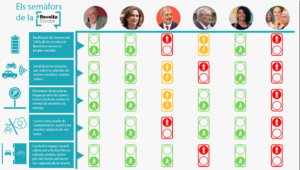
This morning Barcelona awakes to the first day of a post-Colau city. In this blog post I want to cover three key post-election questions.
- First, what are the implications of a post-Colau leadership for the city?
- Second, does voter rejection of Mayor Colau illustrate another instance of ‘bikelash’ or the voter rejection of the transformative urban policies such as Superilles and green axes?
- Third, what positive outcomes might we see from a Trias government?
What are the implications of a post-Colau city?
First, let us examine the program of Xavier Trias, the candidate who won the election. In the mobility debate organized on 9 May 2023, the Trias candidacy clearly articulated that:
- They were against congestion charging
- They were against improved cycling infrastructure for all ages and abilities
- They were against traffic calming measures and reductions in speed limits
- They were against transforming a highway into a liveable space (c/Aragó)
During the campaign, the candidate boasted that “Barcelona is a motorcycle city” and that “cars have nothing to do with climate change” …. leaving many astounded.

Assessment of policies for Mayor by the #RevoltaEscolar movement for safer streets for kids.

Assessment of the electoral program by Eixample Respira
This moderate-to-conservative political program that will replace the Colau government implies that Barcelona will lose recognition and standing on the international stage of innovative urban planning and design. Furthermore, the city planning community around the globe will lose a leader who has been a source of inspiration and an example for undertaking brave and transformative changes in her city.
For the last eight years, Barcelona has become a global leader and role model for cities looking to quickly transform their city and adapt to climate change. The architectural and planning team in the Colau government have shown a willingness to take risks and push boundaries in the creation of high-quality public spaces, protecting children and elderly, improving cycling infrastructure, and preparing the for a climate resilient city. The mayors of London and Paris have been highly supportive of Mayor Colau and her team, precisely for the innovative and transformative changes taking place here. Cities leaders around the world adore Barcelona. They travel here to admire the high-quality public spaces, the Superblocks and the progressive leadership. Only two weeks ago, the city hosted a research team from the Active Travel Academy of the University of Westminster (United Kingdom). Countless journalists, academics and practitioners have contacted me eager to learn “how Barcelona has do so much, so fast”.
Removing Ada Colau and her team from the global stage of Mayors will be a big loss for the city planning community. City leaders in Europe, North America and Latin America found inspiration in Barcelona. Her contributions went beyond what took place in Poblenou or the Eixample, but had a ripple effect for cities around the world. The Trias program does simply not have this vision or stature. There is no transformative vision for the city.
Therefore, the most important implication of the election is the removal of Ada Colau from the global stage as a leading, progressive voice for innovative and transformative city planning. It is difficult (but not impossible) to see Trias taking on that same role. Barcelona will still shine, because it is an amazing city, but it will no longer lead.
Ada Colau’s defeat is not ‘bikelash’
So did voters reject Ada Colau because of her policies? Was her defeat symptomatic of ‘bikelash’ or a rejection of the forward-thinking city model she proposed? This an interesting question, and the idea of ‘bikelash’ is one that my colleague Oriol Marquet has been thinking about for a while. My take would be, no. I do not see this as an instance of ‘bikelash’ because I see her loss as a reflection of local politics rather than a flat-out rejection of the transformations she led. Colau is a polarizing figure who emerged precisely to upset the status quo. Therefore the city model she proposed for Barcelona has become enmeshed with her political persona. Voters might be uncomfortable with her as a leader, but may also agree with the direction she has moved the city. Certainly, the core voters for the Trias candidacy are upper middle class, car driving, males, who embody the antithesis of the working class, feminist Colau voter. In the campaign, the Trias team aimed to mobilize their base, and took positions that are antithetical to the city model we need. However I am hopeful that reflected campaign rhetoric and that in practice, the Trias team will accept that we need a healthier, greener, safer and more bikeable city with less cars, slower streets, and cleaner air.
What are (positive) outcomes we might see from a Trias government?
Moving ahead in a post-Colau Barcelona may open opportunities that might be difficult to imagine with a post-election hangover. Some voices are hoping that a Left learning coalition may prevent Trias and the pro-car lobby from entering power. I would not be in favour of this strategy. It is healthy for the city to have an entirely new team take the reins. And handing over leadership to the ‘Socialist party’ (sic) would probably be much worse. The Socialists have been pulling the brakes on all of Colau’s most innovative city transformations. Under their leadership, we would not see any innovation.
While many progressive voices are disappointed this morning, let me put forward a few reasons to be more optimistic. Here are three things we might see in the next four years that would be good for the city:
- Mayor Trias could consolidate Ada Colau’s city model for greener and healthier streets
The physical transformations of Barcelona’s city streets (Meridiana, Compte Borrell, Consell de Cent, Girona) will be too popular and too well received for the Trias government to undo. The Consell de Cent project is redefining what an Eixample street should look like. They are redefining the intersections as well. Once these projects are completed, Trias and his team will not be able to turn back the clock. The momentum behind the new city model for greener and healthier streets will be unstoppable.
As a result, it will be Trias and his team who will consolidate the new Superblock model that Colau has executed with success. They will brand it with a different name, and potentially take credit for projects in motion. But consolidation by the political opposition is essential for green streets to become mainstream. Trias may consolidate green streets for the long run. Trias can now de-politicize good urban planning practices by embracing the Superblocks vision. If he does this, and “de-Colau-izes” the Superblocks, it would be a major victory.
One might point out that his political platform was lukewarm on these issues. However I am hoping that the rhetoric in the political campaign was merely political posturing and that the value of superblocks, street calming and her work will be so evident, and so popular, that it will be impossible for Trias and his team to pull back. Four years from now, I hope that we can convincingly say that the Trias government consolidated the vision for Superblock Barcelona.
2. The activist community can push harder
Removing Ada Colau from the halls of power also moves stakeholders back into their original and more comfortable place. City activists may now call for a more ambitious agenda for the city. And climate change is pushing us to demand more radical action now.
We must also accept that Ada Colau was an anomaly that could not last. She came to prove a point and staying in power was somewhat hypocritical. A post-Colau Barcelona might more effectively mobilize the activist community, parents, environmentalists, and children advocates, to demand more.
3. Might a Trias government advance the congestion charging proposal?
Developing and executing a congestion charge or pricing system for vehicle traffic coming into the city is urgent and should be high on the agenda. An exceptional coalition of stakeholders have put together a strong proposal that needs to be moved to the next stage of policy analysis and implementation (see Barcelona22.net).
Barcelona would not be a pioneer in developing a congestion charge, since cities around the world have implemented a program for decades. It is the fairest and most efficient way of improving Barcelona’s air quality, reducing vehicle traffic from the city, improving public space and quality of life of Barcelona residents.
However only Trias and his team has the credibility and political clout to make it happen. They can bring moderates and conservatives on board to this proposal that makes sense from every angle. There are sound economic arguments in favor of congestion charging and all the groundwork has been done already. Therefore if they were to make progress on this issue, it would be one of their greatest contributions to the city.
The End of An Era
Regardless of what happens in the next four years, last night unquestionably marked the end of an era. The post-Colau city re-organizes city activists and elites into their comfortable places. There is the risk that Barcelona takes steps back and ends its global leadership as an innovative city for public space and design. But there may be opportunities for the Trias government to consolidate the Superblock model and continue to make progress on creating healthier and safer streets for all. Hopefully, the momentum created by Ada Colau and her team will be too strong to push back.



Thanks for the article, I enjoyed reading it.
– The change in the number of votes was very small. With appx. 160 votes Colau might have been elected mayor again. The turnout was low in the areas where Barcelona en Comu has most of its supporters.
What struck me as a Barcelona resident:
– No posters asking people to vote with a DATE. So if you don’t follow the news, it’s easy to forget. Not even on the voting card which we received at home. Seems like a no brainer to me – tons of studies showing that a call to action like that increases voter turnout. People tend to forget/be busy with other stuff, so help them remember.
For the city planning part:
– As for the superillas, we live in Sant Antoni/Eixample – and the way they organised the actual construction – which took about a year, seemed to indicate that it would take very long. All blocks were done in parallel, which normally means that then everything takes longer. Instead of finishing blocks before moving to the next, almost every single block on Consell de Cent still has open “to do’s”. As a shop owner or resident in that street/area I would be upset about the delays.
In construction these large projects can now be done within time and even under budget, it just needs a different kind of coordination which was lacking here (essentially creating a contract structure for contractors to work together better and sharing some of the savings with them). For example delivering almost all the stones (pipes, etc.) at one time (and creating a de facto warehouse on the streets) instead of delivering what is needed per day (smaller lot sizes) is terrible to get work done effectively. Same for first putting in all the soil, then letting the people who put in the plants dig holes again – instead of coordinating between them, so they do that together.
For an example of good planning, see how they built the Empire State Building more than 100 years ago, in less than a year: https://chrisgagne.com/1255/mary-poppendiecks-the-tyranny-of-the-plan/